Bar Kochba
Roman-Jewish Wars: name of several military engagements between the Roman Republic (later: Empire) and various groups of Jews between 63 BCE and 136 CE.
Simon ben Kosiba
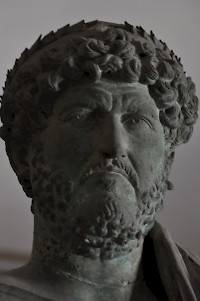
After the revolt of 115-117 CE, the Roman government took several anti-Jewish measures, and it looked as if the old nation had been destroyed. In 130, when the emperor Hadrian visited Judaea, he ordered the construction of a new city to replace the town that Titus had razed to the ground, Jerusalem. It was to be a Roman city, with a Roman temple dedicated to the Roman supreme god Jupiter (text).
The Jewish response to the rebuilding of Jerusalem was divided: although some found it intolerable that foreign religious rites should be performed in their city, others argued that pagans who wanted to sacrifice to the supreme God should not be hindered. This moderate point of view carried the day; after all, was it not written that the Temple was to be "a house of all nations"?
Two years later, Hadrian forbade castration and circumcision, making a law against a practice that had offended Greek and Roman sensitivities for a long time (more). There are indications that he did not forbid circumcision as such, but only the circumcision of boys who had not yet reached the age to consent with the operation; but whatever the precise meaning of the measure, the Jews explained this law as directed against them. Again, there were moderates and radicals; but this time the moderates received less support. As a fourth-century author put it:
At this time, the Jews started a war because they were forbidden to mutilate their genitals.note
Little is known about the initial stages of the revolt. It seems that the spark was put to the tinder in the first months of 132, when the building operations in train to convert the ruins of Jerusalem into a Roman city, caused the tomb of Solomon to collapse. This was seen as a messianic omen. The Roman governor Tineius Rufus severely underestimated the situation.
Soon, the whole of Judaea had been stirred up, and the Jews everywhere were showing signs of disturbance, were gathering together, and giving evidence of great hostility to the Romans, partly by secret and partly by open acts; many others, too, from other peoples, were joining them from eagerness for profit, in fact one might almost say that the whole world was being stirred up by this business.note
To make things worse for the Romans, the Jews found a national leader, Simon, the son of a man named Kosiba. Some of his letters survive, making clear that he was firmly in charge on the first day of the month iyar of the first year of the revolt (3 April 132); he was still able to write on the fourteenth marhesvan of the fourth year (6 November 135). The opening phrases of a Jewish letter from this period deserves to be quoted. It runs 'On the twenty-eighth marhesvan of the third year of Simon ben Kosiba, prince of Israel...' and this style of writing indicates that Simon was seen as the lawful ruler.
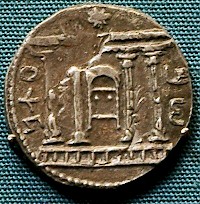
According to the Christian church historian Eusebius (c.260-c.340), Simon claimed to be a luminary who had come down to the Jews from heaven (History of the church 4.6.2). On some of his coins and in his letters, he calls himself 'Prince' (Nasi), a word that had very strong messianic connotations (cf. Ezekiel 37.24-25 and several Qumran documents). His loyal followers liked to make a pun on his name: his real name was Simon ben Kosiba, but he was usually called Bar Kochba (son of the star), which again is a messianic claim. Some miracles were attributed to him: there were reports that he had been seen spewing out flames.
Rabbi Aqiba, the president of the rabbinical academy at Yavne and the official religious leader of the Jews in this age, declared that the successful Jewish commander was the Messiah; at least two rabbis - rabbi Gershom and rabbi Aha - agreed, but others remained skeptical, and said that grass would grow in Aqiba's cheeks before the Son of David would come.
The revolt was clearly religious in nature. The rebels were convinced that this was the eschatological war that had been predicted by apocalyptic prophets like Daniel and Zechariah. Their coins show a star on top of and the Ark of the Covenant inside the Temple; the legend is written in archaic Hebrew letters. Some coins were struck with the legend 'Eleazar the priest', which strongly suggests that a new high priest was elected.
Not everybody agreed to Aqiba's view that Simon was the Messiah. The Jewish Christians refused to accept this claim; the Christian author Justin Martyr tells that Simon commanded Christians 'to be lead away to terrible punishment,' unless they denied Jesus of Nazareth was the Messiah and cursed the man from Nazareth (First Apology 31.6).
Now that things were going wrong, governor Tineius Rufus responded harsh. After receiving reinforcements,
he moved out against the Jews, treating their madness without mercy. He destroyed in heaps thousands of men, women and children, and under the law of war, enslaved their land.note
From the account of the Greek historian Cassius Dio we can deduce that the ensuing war effort of the Jews was extensive, widely supported and fanatical.note But they seem to have failed to take Jerusalem: this seems the only possible explanation for the fact that the rebel coins have been found everywhere in Judaea, except for its capital. On the other hand, there is some (non-conclusive) evidence that a new high priest was elected, which suggests that the Jews controled the site of the Temple at least for some time.
However this may be, it is certain that Simon and his men were able to control the countryside. Legal documents signed by the 'prince of Israel' show that the imperial estates were confiscated and leased out to Jewish peasants.
Simon was so successful, that the emperor Hadrian was obliged to dispatch his best generals to suppress the rebellion. Julius Severus, the governor of Britain, was one of them. Technically, his new command was a demotion, because Britain was a very prestigious province; it indicates the severity of the situation. Other generals were Publicius Marcellus end Haterius Nepos, the governors of Syria and Arabia. Simon knew that the Romans would send a large expeditionary force, and prepared himself.
The rebels did not dare try to risk open confrontation against the Romans, but occupied the advantageous positions in the country and strengthened them with mines and walls, so that they would have places of refuge when hard pressed and could communicate with one another unobserved underground; and they pierced these subterranean passages from above at intervals to let in air and light.note
In December 133 or January 134, Julius Severus superseded Tineius Rufus as governor of the war zone. He commanded a large army. Three legions were deployed: VI Ferrata, X Fretensis - hastily strengthened with marines from Italy - and XXII Deiotariana. No less than seventeen auxiliary units are known to have fought in Palestine. Legion XXII was probably annihilated by the Jews, since there are no indications of its existence after this war. New reinforcements were sent, the legion II Traiana Fortis. There are indications that units from other legions were involved in the struggle, possibly III Cyrenaica, III Gallica and IIII Scythica. For the first time in more than a century, the Romans suffered from manpower shortage; two senators started to conscript Italian boys.
If it were not pleonastic, one would call the war a disaster. The Romans experienced great difficulties when they tried to subdue Judaea, and they made some progress only after the emperor had personally come to Judaea. The Roman soldiers were used to fight full scale battles, but Simon evaded this kind of engagement. Hadrian's generals were forced to form smaller units to intercept small groups of rebels. In this war, the highest ranking officers had to stand by doing nothing, while the under-officers had large responsibilities. Famine, disease and fire proved better weapons than swords and lances.
Severus did not venture to attack his opponents in the open at any one point, in view of their numbers and their fanaticism, but - by intercepting small groups, thanks to the number of his soldiers and under-officers, and by depriving them of food and shutting them up - he was able, rather slowly, to be sure, but with comparative little danger, to crush, exhaust and exterminate them. Very few Jews in fact survived. Fifty of their most important outposts and 985 better known villages were razed to the ground. 580,000 were killed in the various engagements or battles. As for the numbers who perished from starvation, disease or fire, that was impossible to establish.note
It was the type of war the Romans tried to forget. When the Roman author Cornelius Fronto wrote a letter to the emperor Marcus Aurelius on the occasion of the destruction of a legion by the Parthians (in 162 AD), he compared it to the Bar Kochba revolt, implicitly admitting that the latter had been a defeat.
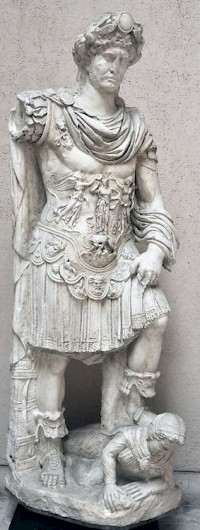
The Romans resorted to terrible atrocities to win the war. Bodies were left unburied for several years. There are three reports that children were wrapped in Torah scrolls and burned alive.note This may be exaggerated, but the Roman legionaries were perfectly capable of acts like these. Many Jews started to regret the rebellion. A new pun on Bar Kosiba's name became popular: some called him Simon bar Kozeba, the 'son of the disappointment'.
Like al wars, it was a human catastrophe. The Christian author Jerome (c.400) writes that the 'citizens of Judaea came to such distress that they, together with their wives, children, gold and silver remained in underground tunnels and in the deepest caves' .note Archaeologists have been able to confirm this statement, when they found human remains, cooking utensils and letters in caves at Wadi Murabba`at and Nahal Hever.
Slowly but surely, the Romans gained the upper hand. Simon made his last stand at Betar, three hours southwest of Jerusalem. The defenders are recorded to have caught the missiles from the Roman catapults and hurled them back. The siege lasted a long time, until the winter of 135/136 (Simon was still able to send letters on 6 November 135). The rebels never surrendered, but died from famine and thirst. Among the dead bodies, the legionaries recognized that of Simon, the son of Kosiba. When they brought his head to the emperor Hadrian, he said: 'If his God had not slain him, who could have overcome him?'
According to Jewish tradition, Betar fell on the ninth day of the month of Av. In the Gregorian calendar, this would be 25 July 136. The date is extremely suspect, however, because this is also the date of the destruction of the Temple in 70. Since Hadrian accepted the title Imperator ('conqueror') late in 135, we must assume that Betar was captured in November or December.
The anecdote about Hadrian's words on seeing the head of Simon, has caused some scholarly debate: was Hadrian really present? The answer is that he was. Roman texts use the expression expeditio Judaica, which can only mean that the emperor was present. Besides, there is an officer from the imperial guard, C. Arrius Clemens, who was decorated for war service in Judaea by the emperor.
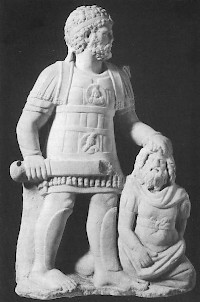
This was not the end of the struggle, however. The recent discovery of a triumphal arch in the neighborhood of Scythopolis (Beth Shean), dedicated in 136 to the emperor by the Senate, proves that fighting continued in Galilee.
Many Romans perished in the war. Therefore, Hadrian, in writing to the Senate did not employ the opening phrase commonly affected by the emperors: 'If you and your children are in health, it is well; I and the army are in health.'note
After the Jewish defeat, Hadrian (the picture shows him killing a Jew) tried to root out Judaism. The prisoners were sold at Hebron and Gaza, each one at the price of a horse. He forbade the conquered to teach Mosaic law and to own scrolls. The province Judaea was renamed Palestine; Jerusalem was called Aelia Capitolina.
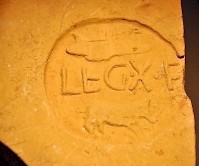
Pagan sanctuaries were erected right over places of Jewish worship: the temple to Jupiter was erected on the site of the Jewish Temple, Hadrian's equestrian statue being placed in the Holy of Holies; the goddess Aphrodite received a new home on the place where the sect of the Christians had venerated the tomb of Jesus, and before the southern gate of Aelia, the Romans erected a marble statue of a pig. (This was the symbol of the Tenth Legion Fretensis, but the insult was obvious and probably intended.) Even worse, the Jews were not even allowed to see their ancestral home town. Rabbi Aqiba violated this edict, and after some time in prison, the old man was tortured to death; at least nine other rabbis were executed, too.
The world was not to see Jewish armies anymore until 1915, when the British recruited a unit with the remarkable name of 'Assyrian Jewish Refugee Mule Corps', which was to play a role during the Dardanelles campaign.
After the death of Hadrian, reconciliation started. The new emperor Antoninus Pius allowed the burial of the dead and repealed the ban on circumcision that had caused the war (Digests 48.8.11). The rabbis started a self-critical discussion. Messianic claims in general were considered suspect. When Yehuda ha-Nasi composed that large collection of rabbinical wisdom, the Mishnah, he left out many messianological speculations. Politically, Judaism was dead; there was to be no Jewish state for more than eighteen centuries. What was left, was the religion, which easily survived Roman paganism.